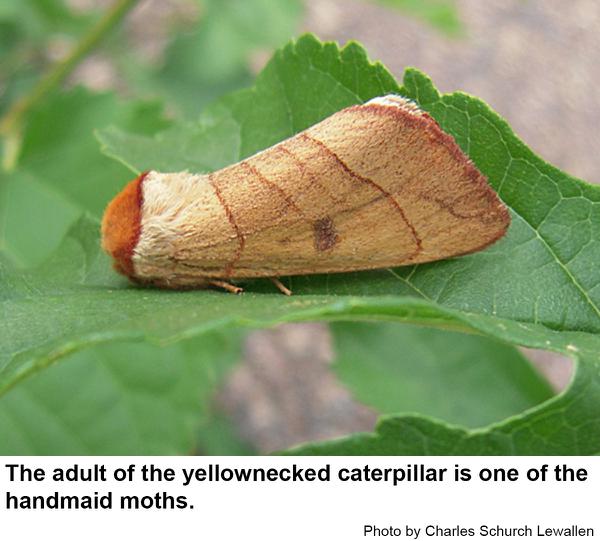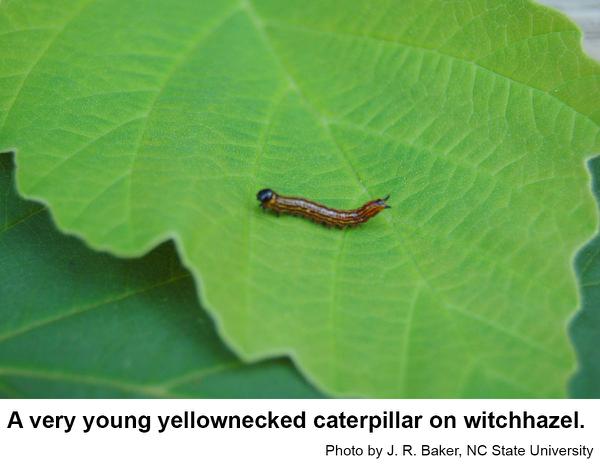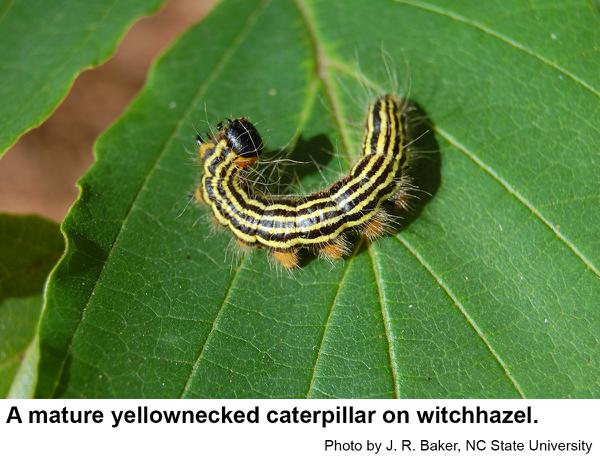Description and Biology
The yellownecked caterpillar, Datana ministra, is one of the most frequently reported pests of oaks, birches and other hardwoods. Young caterpillars are small green worms that grow into medium orangish worms with yellow stripes and then into large (about 2 inches long), black- and yellow-striped caterpillars with black heads and reddish prolegs. The body is covered by long, fine, white hairs. Behind the head is a bright yellow to orange patch from which this insect's common name is derived. Moths emerge from the soil during June and July. Male moths are sometimes attracted to lights. Moths are reddish to cinnamon brown, and the forewings have irregular, fine dark lines. The wingspread is about 2 inches. Females lay their tiny, white eggs in masses — sometimes a 100 or more — on the lower surface of leaves. The larvae typically feed in groups near the ends of the twigs and branches. When disturbed the whole group often elevates both ends of the body, a behavior that predators might find intimidating. In August and September, the mature caterpillars burrow into the soil 2 to 4 inches and pupate to spend the winter there. There is one generation per year.
Host Plants
Oaks are among the favorite hosts of yellownecked caterpillars, although it also feeds on basswood, birch, elm, honeylocust, oak, maple, mountain-ash, walnut and witchhazel. This insect is also destructive on blueberry, apple, and other fruit trees.
Residential Recommendations
Yellownecked caterpillars are parasitized by tachinid flies and are preyed upon by insects and birds. Because yellownecked caterpillars feed gregariously, they can be dislodged from low branches and trampled underfoot if one has the stomach. Sevin or one of the other insecticides labeled for home use should give adequate control. Once the caterpillars mature and crawl about seeking a place to dig into the soil, they are much less susceptible to insecticides.
References
- Caterpillars in blueberries (and other woody perenials). Burrack, H. 2009. NC Small Fruit & Specialty Crop IPM.
- Tree Fruit Insect Pest - Yellownecked Caterpillar, Datana ministra (Drury). Hoover, G. A. Sr. 2013 (revised). Insect Advice from Extension, Department of Entomology, PennState College of Agricultural Sciences.
- Yellownecked caterpillar, Datana ministra. Krischik, V. and J. Davidson. 2013 (modified). Pests of Trees and Shrubs. IPM of Midwest Landscapes.
- Extension Plant Pathology Publications and Factsheets
- Horticultural Science Publications
- North Carolina Agricultural Chemicals Manual
For assistance with a specific problem, contact your local Cooperative Extension Center.
This Factsheet has not been peer reviewed.
Publication date: Feb. 3, 2017
Revised: Nov. 13, 2021
Recommendations for the use of agricultural chemicals are included in this publication as a convenience to the reader. The use of brand names and any mention or listing of commercial products or services in this publication does not imply endorsement by NC State University or N.C. A&T State University nor discrimination against similar products or services not mentioned. Individuals who use agricultural chemicals are responsible for ensuring that the intended use complies with current regulations and conforms to the product label. Be sure to obtain current information about usage regulations and examine a current product label before applying any chemical. For assistance, contact your local N.C. Cooperative Extension county center.
N.C. Cooperative Extension prohibits discrimination and harassment regardless of age, color, disability, family and marital status, gender identity, national origin, political beliefs, race, religion, sex (including pregnancy), sexual orientation and veteran status.




